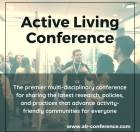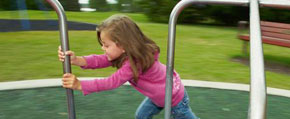We are pleased to announce an exciting new alliance between Active Living Research and GP RED to co-host and coordinate...
Caminando con Fe (Walking with Faith): Promotoras Advocating for Built Environmental Changes to Promote Physical Activity
Presentation at the 2009 Active Living Research Annual Conference
Background:
Latinas’ physical activity (PA) is among the lowest compared to other ethnic groups. Churches are a central institution in the Latino community and are committed to the well-being of their members. Churches offer space for meetings and PA programs, as well as volunteers eager to be trained as Lay Health Advisors or promotoras. Promotoras have the capacity to influence individual, social, and policy change. A large percentage of Latinos living in the Southwestern region of the US report attending church services and the majority live near their church. Therefore, improving the “activity-friendliness” of churches and church neighborhoods is highly relevant.
Objectives:
To describe the impact of a promotora-driven environmentally-focused PA intervention on the built environment.
Methods:
The current program uses a mixed-method approach. A 12-month environmental intervention was implemented to improve the built environment in and around the selected church. WalkSanDiego (WSD) trained four promotoras to assess the built environment and make walkability improvements. The environmental targets were separated into tiers: Tier 1 included the church parcel and Tier 2 involved the block around the church and a neighboring park. To assess Tier 1 and Tier 2 environments prior to intervention implementation, modified versions of the Bedimo-Rung Assessment Tool (BRAT-DO) and the Irvine Minnesota Inventory (IMI) were used. Process evaluation data were collected to evaluate changes in the built environment. Community members were surveyed to assess environmental factors that influence their park usage.
Results:
The promotoras involved the church community in walk and park audits to identify environmental barriers to PA and noted that the park lacked bathrooms, had a dilapidated fence, had limited water fountains, and an open sewage drain. The community survey results indicated that only 20% of those surveyed visited the park during the week (22% on the weekend). Factors that inhibited park use by community members were lacking bathrooms (67%), lighting (58%), water fountains (60%), trash bins (73%), and recycling bins (67%). The majority (80%) of surveyed participants stated that homeless in the park discouraged use. These findings corroborated promotoras’ observations and complimented the report they prepared prioritizing environmental targets and providing solutions to these environmental problems.
The promotoras presented the Tier 1 and 2 reports to church leaders for approval to make changes on the church grounds. The promotoras organized walking groups to gain support for and address built environment improvements. To address Tier 1 changes, the promotoras organized church clean-up days with the walking groups. To raise money to renovate the basketball court, landscaping around the church, and add lighting, the promotoras planned a community sale with partners (church leadership, Fire Department, radio, etc.) and solicited donations from local businesses. To implement Tier 2 changes, the promotoras collaborated with the youth involved with Healthy Eating Active-Communities, a coalition funded by the California Endowment, to promote healthy, active environments through policy and environmental changes in the targeted community. Consequently, a councilmember and city staff (engineering, police, landscape architecture, parks, recreation, general services, etc.) met with the promotoras and community partners to discuss areas for park improvements. As a result of the promotoras and partners advocacy efforts, many additional improvements were made to the park and a new relationship was formed between the City and the church, whose property line is adjacent to the park.
Following 12 months of the environmental intervention implementation, the following changes were made on church grounds (Tier 1): renovated basketball court, improved landscaping, decreased trash and graffiti, and increased security (i.e. lighting, relocated storage container, better signage). The following Tier 2 changes were made in the church neighborhood: increased park security (i.e., lighting, fencing, overgrown plants removed), improved park safety (i.e., covered sewer drain, sand lot removed), enhanced park amenities (i.e., water fountain, bathroom, benches, tables), improved pedestrian safety in park (i.e., leveled and new walking paths), improved children’s play area (i.e., new play equipment, fencing), removed trash around the block (i.e., church clean-up walks), and improved pedestrian safety (i.e., undergrounding of utility poles in preparation for sidewalk installation). The park is scheduled to be re-inaugurated September 2008 and post-intervention assessment will be completed October 2008.
Conclusions:
This study provides an empirical basis for selecting built environment change targets that can be advocated for by promotoras, youth, church governing bodies, and church members. The information presented will include the types and length of environmental advocacy activities and barriers/facilitators to built environmental changes that the promotoras encountered. This partnership can be used as a model of how collaboration can maximize efforts, bring political support, and leverage resources under budget constraints.
Support:
These efforts were funded by NIH/NCI R21CA12247
STAY UP TO DATE
RECENTLY ADDED TOOLS & RESOURCES
MOVE! A BLOG ABOUT ACTIVE LIVING
The "Active Living Conference" aims to break down research and practice silos and...







